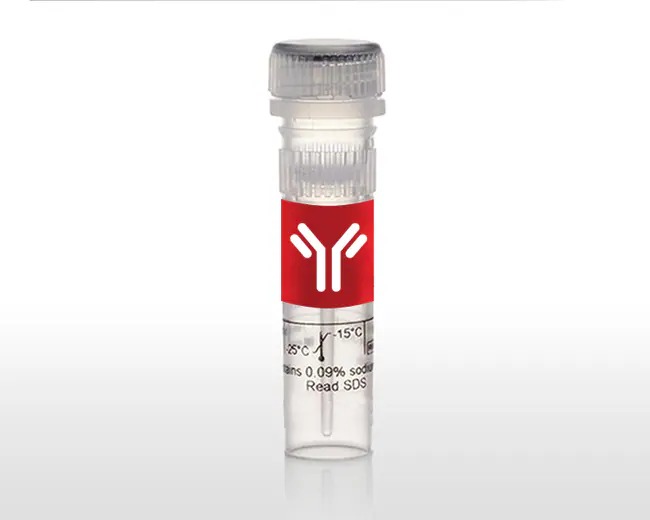Invitrogen™ eBioscience™ CD199 (CCR9) Monoclonal Antibody (BBC3M4), PE, 100 Tests
Catalog No :
CAS Number :
Brand :
In Stock
Specifications:
| Application | Flow Cytometry | ||
| Storage Temperature | 2-8°C | ||
| Product Type | antibody | Forms | Liquid |
| Product Brand | Thermo Fisher Scientific™ | ||
| Product Grade | Molecular Biology | ||
The Invitrogen™ CD199 (CCR9) Monoclonal Antibody (BBC3M4), conjugated to PE (Phycoerythrin), is a high-quality antibody designed for detecting CD199 (CCR9) on human cells. CCR9 is a G-protein-coupled receptor that plays a key role in thymocyte development and immune cell trafficking to gut-associated tissues. This antibody is optimized for flow cytometry applications, providing bright fluorescence for accurate identification of CCR9-expressing cells.
Key Features:
- Target and Specificity:
- Recognizes CD199 (CCR9), a receptor expressed on thymocytes and immune cells involved in gut-associated tissue trafficking.
- High specificity ensures reliable detection in flow cytometric studies.
- Clone and Conjugate:
- Clone: BBC3M4, a trusted and validated clone for CCR9 detection.
- Conjugate: PE (Phycoerythrin), offering bright fluorescence with excitation at 565 nm and emission at 576 nm.
- Validated Applications:
- Designed for flow cytometry, enabling robust analysis of CCR9 expression in human immune cells.
- Bright and Stable Fluorescence:
- PE provides high signal intensity, making it ideal for detecting low-abundance targets like CCR9.
- Pre-Titrated and Ready-to-Use:
- Requires only 5 µL (0.125 µg) per test, simplifying experimental workflows.
Specifications:
| Attribute | Details |
|---|---|
| Catalog Number | 12-1999-42 |
| Target | Human CD199 (CCR9) |
| Clone | BBC3M4 |
| Host/Isotype | Mouse / IgG1, kappa |
| Conjugate | PE (Phycoerythrin) |
| Applications | Flow Cytometry |
| Species Reactivity | Human |
| Concentration | 5 µL/Test |
| Formulation | Liquid, in PBS (pH 7.2) with 0.2% BSA and 0.09% sodium azide |
| Excitation/Emission Max | 565 nm / 576 nm |
| Storage Conditions | Store at 4°C, protect from light, do not freeze |
| Unit Size | 100 Tests |
| Recommended Isotype Control | Mouse IgG1 kappa Isotype Control, PE |
Applications:
- Flow Cytometry:
- Detect surface CCR9 expression in human thymocytes, CD4+ T cells, and other immune cell subsets.
- Analyze immune cell trafficking to gut-associated lymphoid tissues (GALT).
- Thymocyte Development Studies:
- Investigate CCR9’s role in thymocyte migration and maturation during development.
- Gut-Associated Immunity:
- Study the upregulation of CCR9 in response to dendritic cell-derived retinoic acid and its involvement in gut immunity.
- Chemokine Receptor Research:
- Analyze CCR9's interaction with its ligand CCL25 (TECK) and its role in immune cell localization.
Key Benefits:
- Bright and Stable Fluorescence:
- PE ensures high signal intensity for clear separation of CCR9-positive and negative populations.
- Reproducible Results:
- Pre-titrated and validated for flow cytometry, providing consistent and reliable data.
- Versatility:
- Suitable for studying thymocyte development, gut immunity, and chemokine receptor pathways.
- Ease of Use:
- Ready-to-use liquid formulation simplifies experimental workflows.
- High Specificity:
- The BBC3M4 clone offers reliable detection of CCR9 in human immune cells.
Usage Recommendations:
- Sample Preparation:
- Isolate human CD4+ T cells or other CCR9-expressing cells from peripheral blood or tissue samples.
- Staining Protocol:
- Add 5 µL (0.125 µg) of antibody per 100 µL of cell suspension.
- Incubate with cells in the dark for 20–30 minutes at 4°C or room temperature.
- Flow Cytometry:
- Analyze stained samples using a flow cytometer equipped with a blue laser (488 nm), green laser (561 nm), or yellow-green laser.
- Controls:
- Use an isotype control (e.g., Mouse IgG1 kappa Isotype Control, PE) for gating and specificity assessment.
Storage and Handling:
- Store at 4°C in the dark to protect the PE fluorochrome.
- Do not freeze, as freezing may degrade the antibody or fluorochrome.
Target Information:
- CD199 (CCR9):
- A G-protein-coupled receptor involved in thymocyte development and immune cell migration.
- Plays a role in the localization of immune cells to the gut through interactions with its ligand, CCL25 (TECK).
- Regulated during thymic development and upregulated in response to retinoic acid signaling.
For Research Use Only:
This product is intended for research purposes only and is not for diagnostic or therapeutic applications.




 0
0
